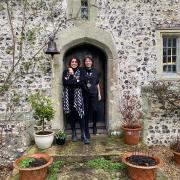The priest, author and television presenter reflects on the autumn ritual of gathering in nature’s bounty

It is something ingrained, I think, learned over the years. For those of us living on this windswept island in the north-east Atlantic, October is the time to prepare for the winter months that lie ahead, to make ready. I remember my mother laying down apples on racks in a tumbledown shed at the back of the garden. We’d gather them, green and gleaming, in buckets and then on a February morning the wrinkle-skinned fruits would appear, having lost much of their original vigour. Now I tramp the woods collecting bags of kindling before the canopy loses its leaves and the autumn skies render everything damp, but under one tree there is treasure.
The common walnut tree was brought to these shores by the Romans, spreading as it did after the last ice age from an enclave in south-east Europe. The black walnut tree is indigenous to north-east America, was introduced to Europe in 1629 and very much prefers the warmer southern half of this island. It is their leaves that distinguish them – the common walnut has between five and nine pairs of oval-shaped leaves on each leaf stem, whereas the black walnut has between seven and nine tooth-shaped leaves on every stem. All the same you will need to find these trees before the squirrels do as they will unashamedly take, eat and bury the whole lot.
MORE: Read Peter’s September column here
But there are some trees high on the Downs that the squirrels haven’t yet risked running over the open ground to reach. By mid-October the green fleshy casement around the nuts is beginning to split and they are falling from the branches. If you are lucky enough to find an untouched tree or two there are usually several pounds of walnuts lying there in the grass underneath them. Some are without their green casement which, once it has fallen, quickly turns black and mushy and smells of turpentine. I find the best way to extract the nut is to gently roll the casement under your feet, or you can take them home just as they are and let nature do the work of separating the counter-layer from the inner treasure. But don’t leave them outside the back door as I did a couple of years ago. I woke up one morning to find all but three had disappeared in the night. Yes, our friend the squirrel had found my stash.
You can pickle young walnuts but to do this they need to be picked when the fruit is completely soft in June. I would rather see them produce their seed, let the season circle. And of course once the hoard is at home there are some very fancy recipes to be found online offering the joys of candied walnuts, chocolate walnut fudge or spaghetti with blue cheese and walnuts. I simply store the nuts in a dry cool place and then hand them out as they are at Christmas.
But the joy is in the process, the gathering in, as it says in the Harvest hymn “all is safely gathered in ere the winter storms begin.” What pleasure there is in walking out on an autumn afternoon and returning at dusk with some winter bounty. On the way home I always take two or three nuts out of the bag and heel them into a goodly place in the earth where maybe one day there will be a new tree. There’s surely a bit of a squirrel in all of us.
Join the conversation on our Facebook, Twitter and Instagram pages




























